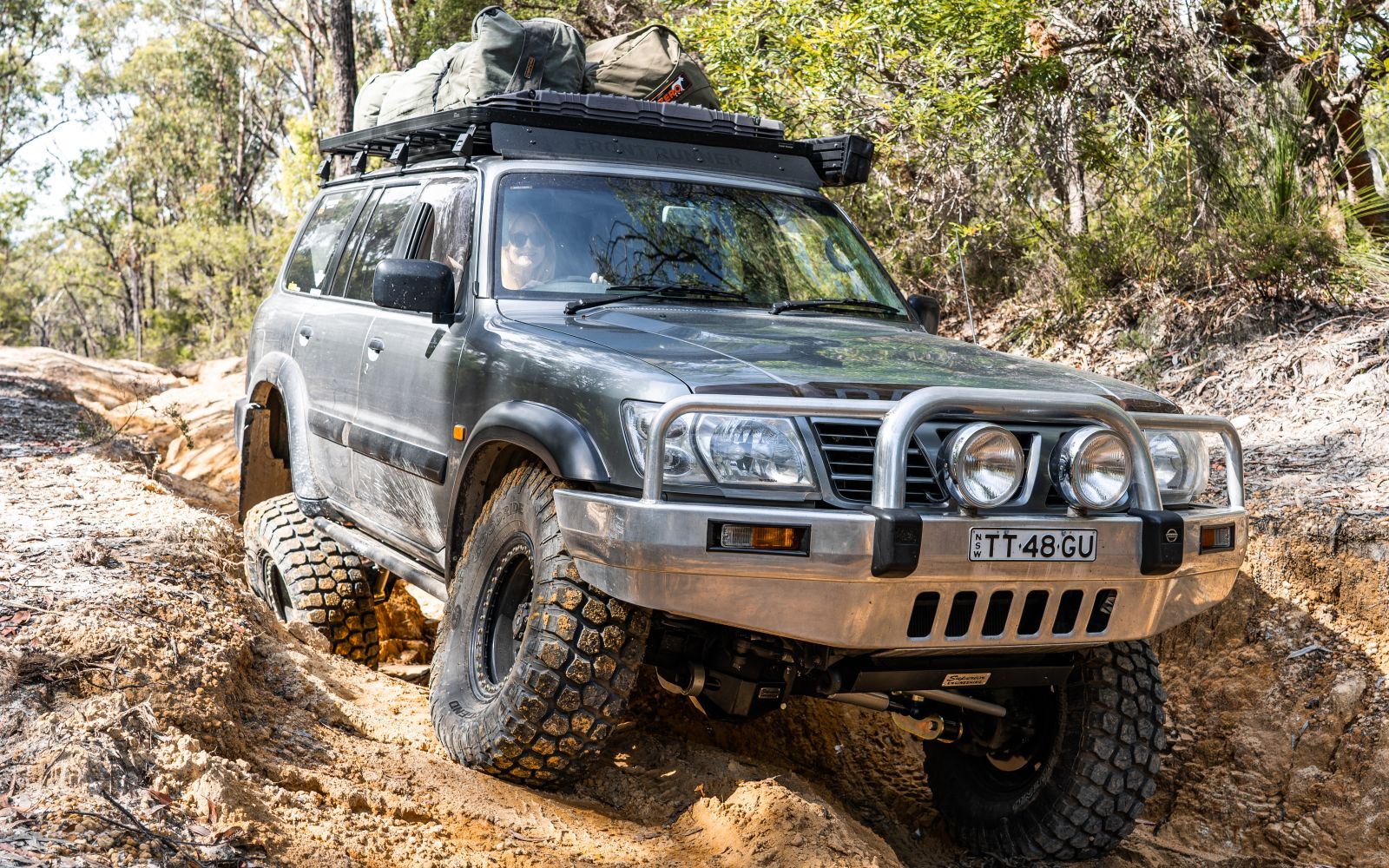
4WDs were always destined for more than just a people carrier. They were built to tackle the wild, be pushed to their limits, and allow you to explore the outback with ease. But before you venture off sealed roads, it’s important to carry all the gear you’ll need to not only enjoy yourself, but to get home safely. Here are 10 must-have 4x4 accessories that are essential to have prepared if you're tackling the outdoors.
Bull Bars:
The danger of driving on rural roads often isn’t other vehicles – it’s wildlife. Bull bars are also designed to protect the front of your vehicle when tackling some of the harder 4x4 tracks you'll come across. Kangaroos can hit speeds up to 70 km/h, so if one crosses the road in your path, there’s a chance you’ll have no time at all to respond. The only reasonable way to keep you and your vehicle safe is a full bull bar. Wrapping around the front grill and side pillars, any animals that may cross your path will be kept off your bodywork, causing minimal damage. The main reason you would protect the front, is that your headlights are the most important safety aspect when driving at night. Without them it will certainly limit where you can go, which is why below we discuss some of better choices for adding extra driving lights.
Driving Lights:
Between dark country roads and misty trails, the world is looking for any chance to pull the wool over your eyes. But with some quality lights fitted, you'll be able to see much further ahead, which can often mean the difference between being able to turn around after seeing an obstacle that is too extreme to drive through. Choose from light bars or driving spotlights, depending on the type of light you'd like to cast. Driving spotlights will certainly give you that extra kilometre or too of vision, whereas a light bar will cast a wider, more spread out field of vision which is better for camping.
Recovery Points:
Generally, the easiest way to ensure your vehicle is ready to be recovered is with a rated recovery point. However, there are a few alternatives. A bull bar can serve as a way to recover yourself from the front of your vehicle (provided it’s an included option, and the points are rated to work as such). If you do plan on heading into more challenging tracks, it's always best to go in a convoy or at least have a winch installed. When recovery from the front try to distribute the weight across both points at the front so you don't risk damage to the chassis. By spreading the weight across the front, you will see better results from snatching and towing when using kinetic ropes. You’ll also want to make sure there’s an equally strong point at the rear. The tow bar can double as a rear recovery point provided that you have one installed, but never use the tow ball itself. We stock a great range from TAG, for vehicles that have had canopies installed or do not come stock from factory. Attaching a Saber recovery hitch to your hitch receiver provides a safe recovery point and you’ll be ready to roll.
Cargo Barrier:
For 4WD owners, keeping your boot separate from the cabin isn't just a luxury - it's a necessity. In the event of a crash or severely rough road, luggage flying forward can be more dangerous than the impact itself. If you’re headed off the beaten track, don’t risk taking a needless knock. Get yourself a cargo barrier and have peace of mind on those rough roads. They also make a convenient way to store loose items by simply attaching a carabiner through the holes or mounting an extra shelf for even more storage space.
Rear Drawers:
The easy way to keep loose units from flying around your cabin like a rogue snow globe is a trusty set of drawers. Rear drawers for 4WD's or even sedans are a great option for people who are travelling long term and need a place to store valuabe equipment and tools. For those of you who are about to attempt the lap of Australia, a set of rear cargo drawers are an essential when needing quick access to recovery gear and items that need to stay clean and dry to function properly. 4WD cargo drawers from Front Runner are some of the highest quality and most popular with many of the new vehicles on the market. Check out some of the rear drawers from 4WD interiors, with a huge range of designs and options for some of the older models as well.
Dual Battery System:
There’s no worse feeling than tackling a troublesome trail, then not being able to head home. Don’t let a flat battery force you into calling for help – have a trusty spare battery at the ready. There are hundreds of ways to set a dual battery system, but here at Outback Equipment we've narrowed it down to a fine art. For 4WD's that have bigger engine bays, a battery tray and secondary battery being wired up to an isolator switch in the front is about the simplest way to keep your accessories/devices topped up while on the road. The isolator switch allows you to choose which battery you want to charge from either the alternator or a fixed solar panel. It's always a good idea to install and battery monitoring system so you can easily keep an eye on charge levels. For the ultimate in battery monitoring and battery managment you can't go past the Redarc DCDC battery charger.
Tyre Pressure Gauge/Compressor and Patch Kit:
In the same spirit as the spare battery, a leaky tyre can wreak havoc in the outdoors. Patch kits won’t be able to help if you’ve torn the side off the tyre, but if you’ve only sustained a small puncture, you’ll at least be able to get home safely. A tyre deflator makes quick work of letting air out of your tyres and can also help if you’re letting air out to cross loose surfaces, such as sand. Choose from a range of options depending on how fast you need to inflate and deflate. You won’t want to do the entire trip home on a single-digit PSI so ensure you are carrying the best air compressor with you.
UHF or HF Radio:
When travelling with a convoy, in areas where there is no phone reception a UHF radio is probably the most essential piece of gear you can carry. A number of things can go wrong on challenging tracks and clear communication can be the difference between making it out undamaged or trapped in a rut. Other than for a bit of fun with friends, a radio can be your saviour in the wild. After all, there are no guarantees when the next car will pass. It’s worth making yourself familiar with the emergency channels on UHF. Handheld radios are a bare minimum but tend to run out of battery fairly quickly if used all day, but do come in handy when spotting a mate over a difficult obstacle. We highly recommend installing both a fixed UHF radio and portable system on serious journeys.
Recovery Boards:
Recovery boards are with out a doubt one of the most essential 4WD accessories to take with you when heading abroad. They are there to assist your vehicle in situations that may arise when the traction on the road or pathway doesn't allow for you to safely cross. Recovery boards can be used for many different scenarios, like a platform to change a tire, directing your vehicle out of a slippery bank, a way to prevent your vehicle from sinking in grass or mus overnight or even as a make shift shovel in extreme cases. Carrying two recovery boards should realistically get you out of most sticky situations but from experience, if you are not travelling in a large convoy, 4 recovery boards are highly recommended in places that may have large ruts. You can use them to pad out parts of the track that require momentumn to get over the obstacle. Mounting your recovey boards are also a widely discussed topic and there are many different ways you can do this. From rear wheel mounts, roof rack mounts or the old trusty rachette straps, Outback Equipment has the right gear for the job. We find that for weekend trips or when just putting the old girl to the test at your local spots, rachette straps are the easiest as they can be undone and resecured quite quickly, especially when they are covered in mud. The more permanent mounting kits from Front Runner, MaxTrax and Exitrax are great for long journeys where they will only be used in a pinch. Some recovery board mounting kits are lockable and you can be sure they won't shake loose overtime.
Shovel:
It’s probably not the first 4WD accessory that springs to mind. But with a trusty shovel by your side, you’ll be ready to tackle:
-
Bogged vehicles
-
A makeshift toilet stop
-
Digging a fire pit
-
Spreading coals around your campfire and onto the lid of your camp oven
Is there something else you’ll need on your trip? View the entire range of 4x4 accessories online.


.png)